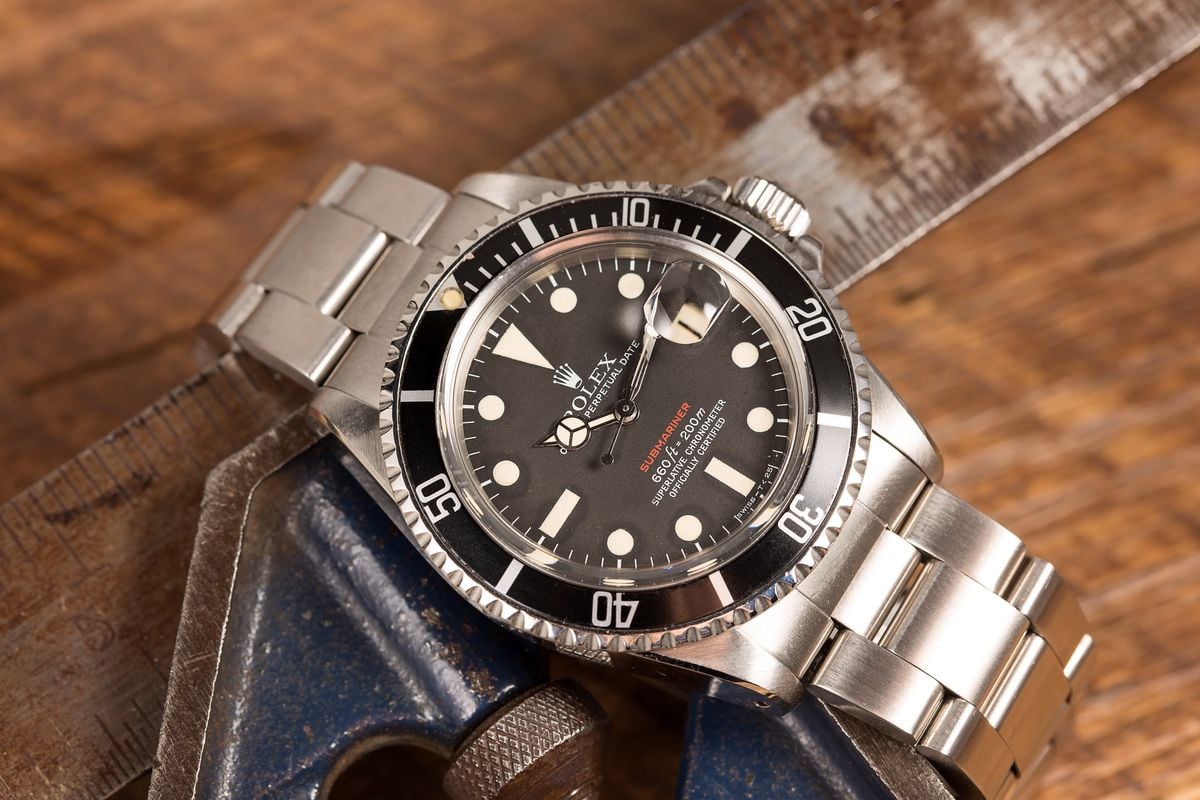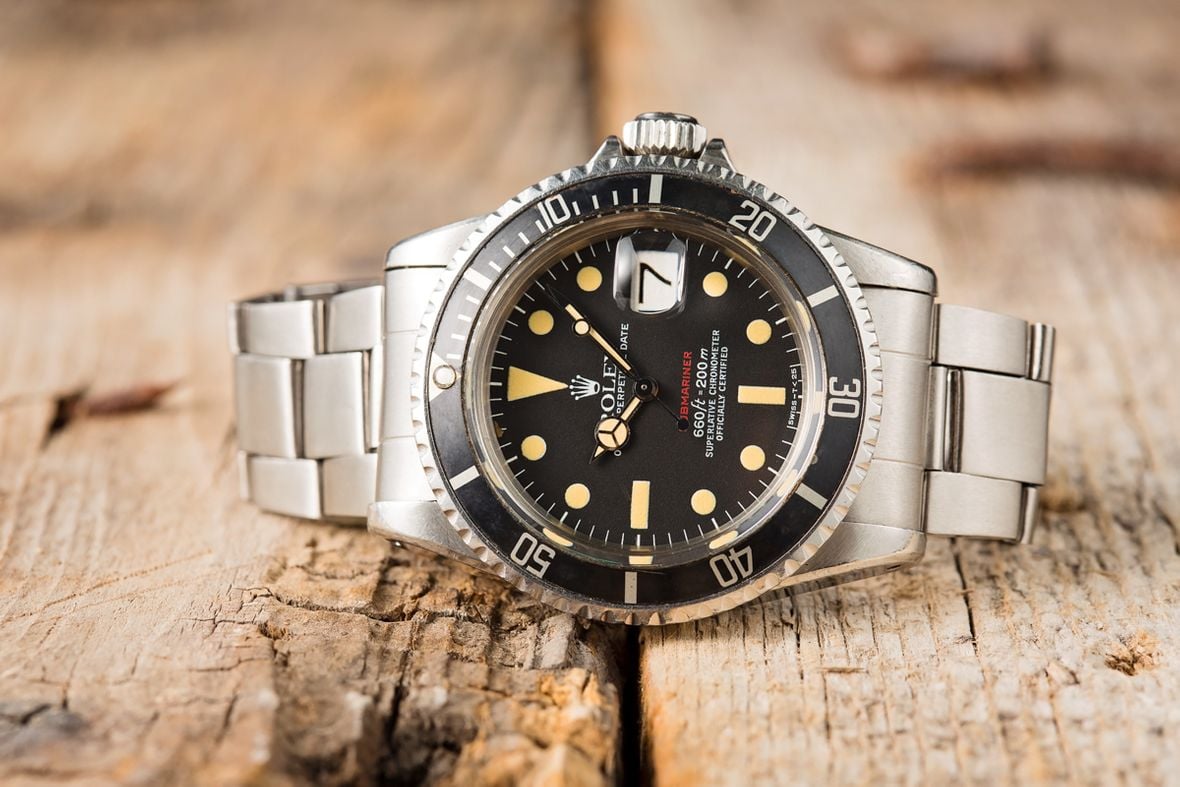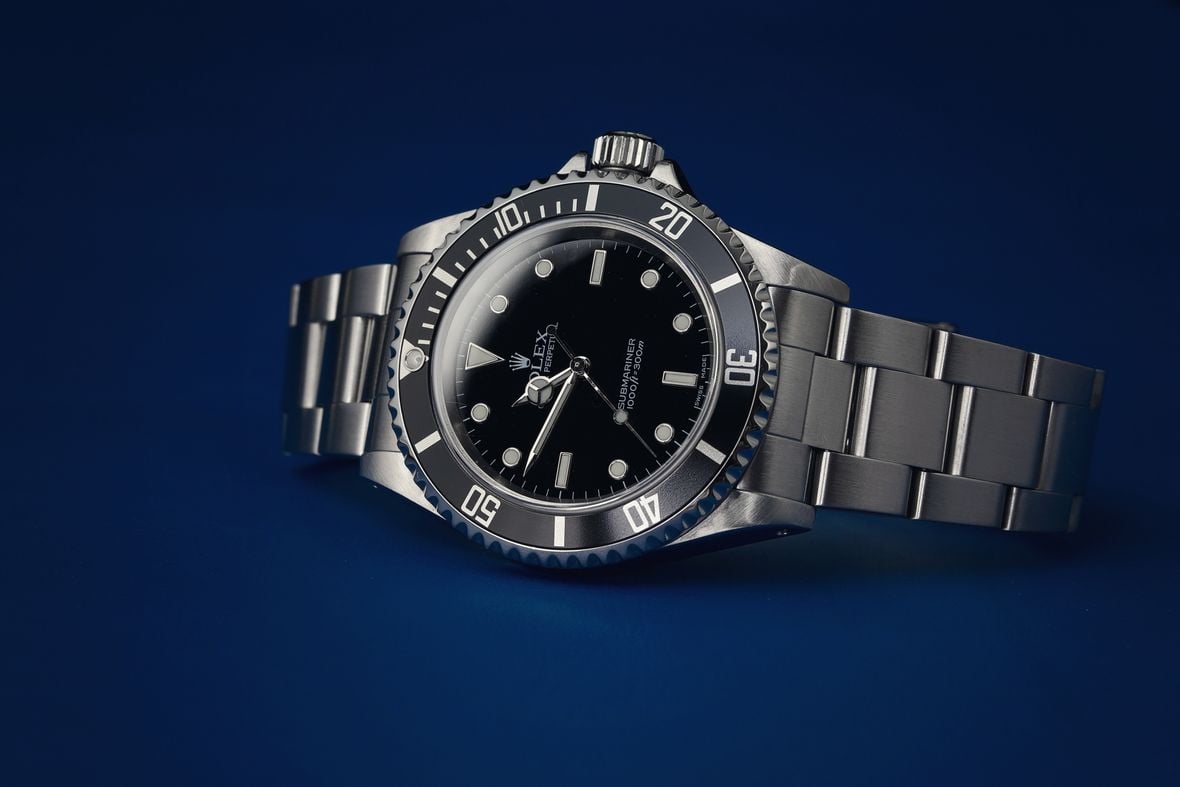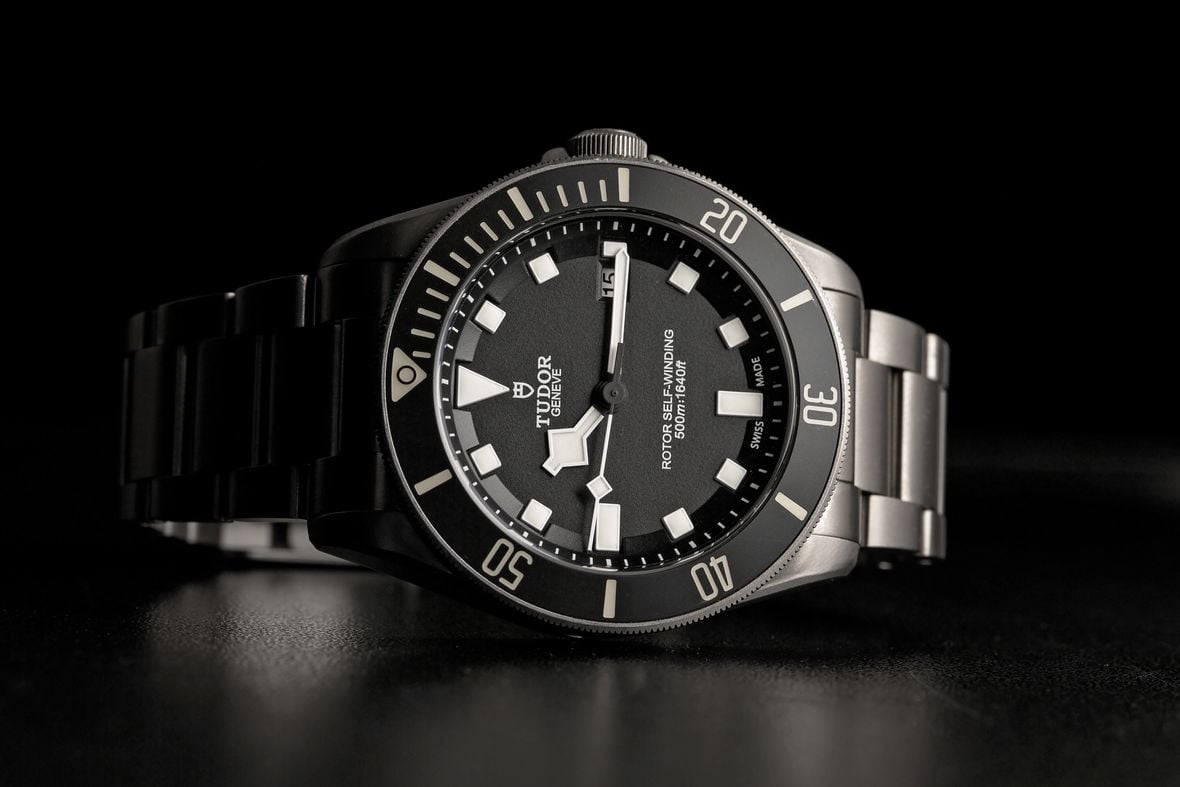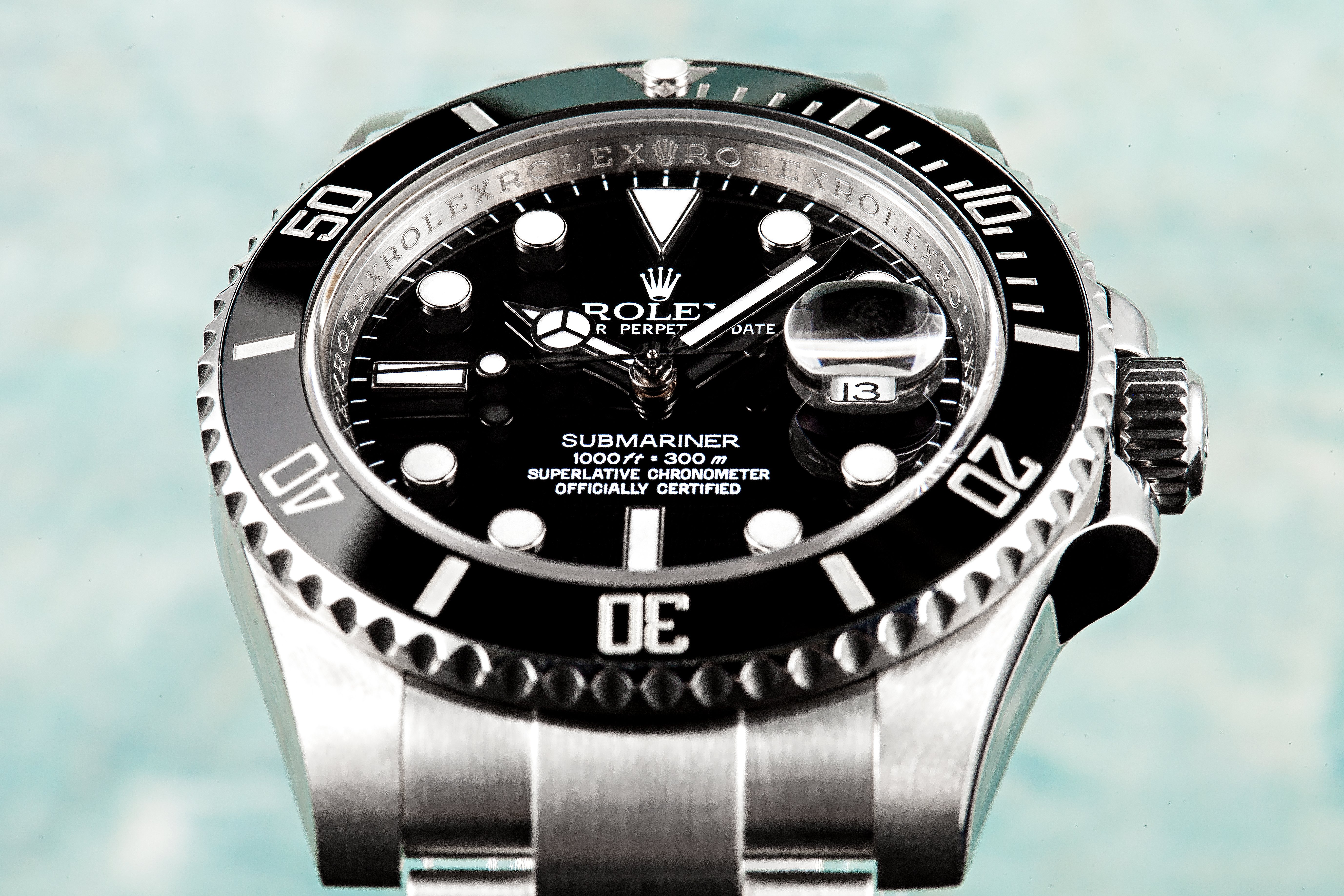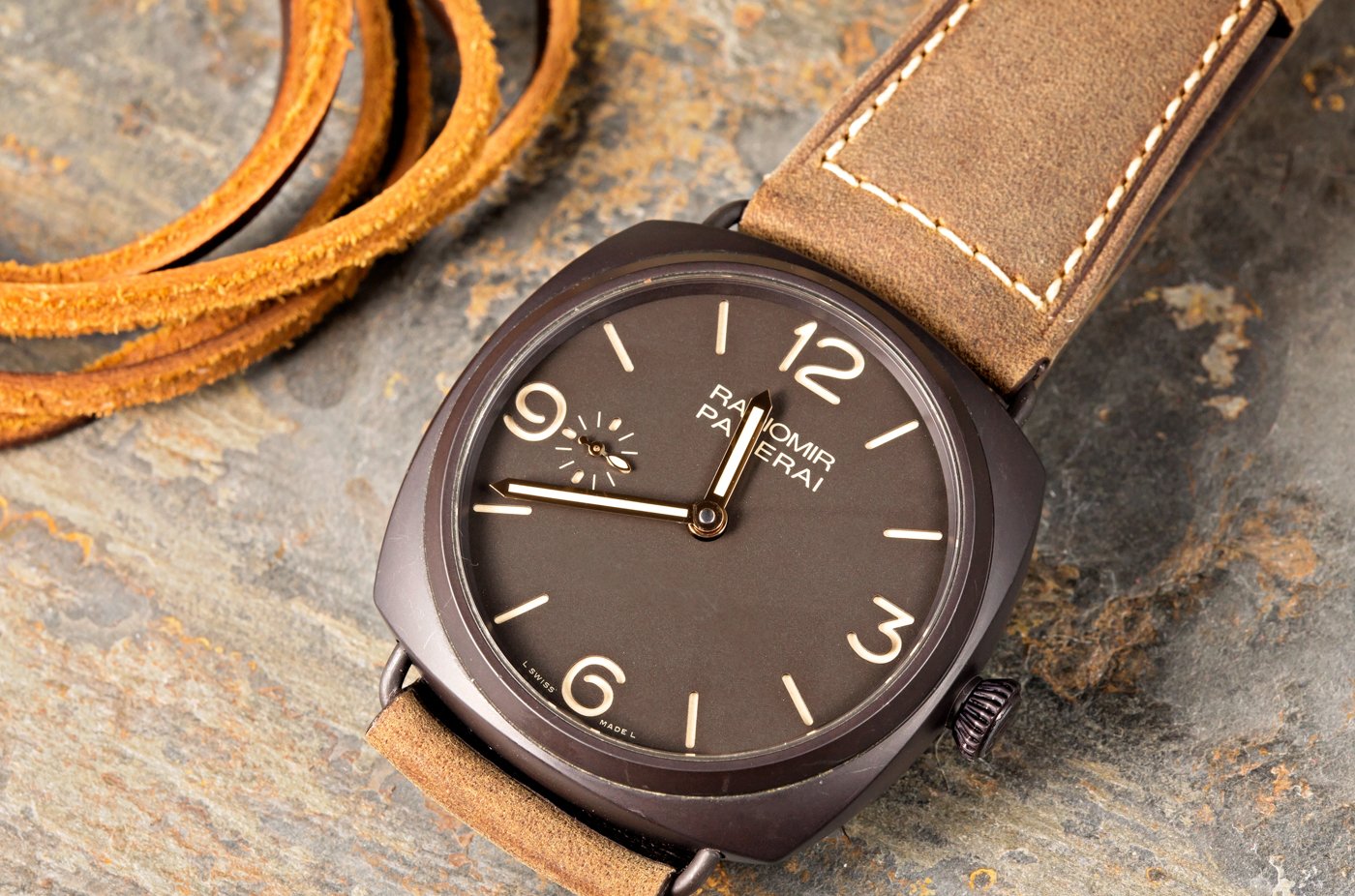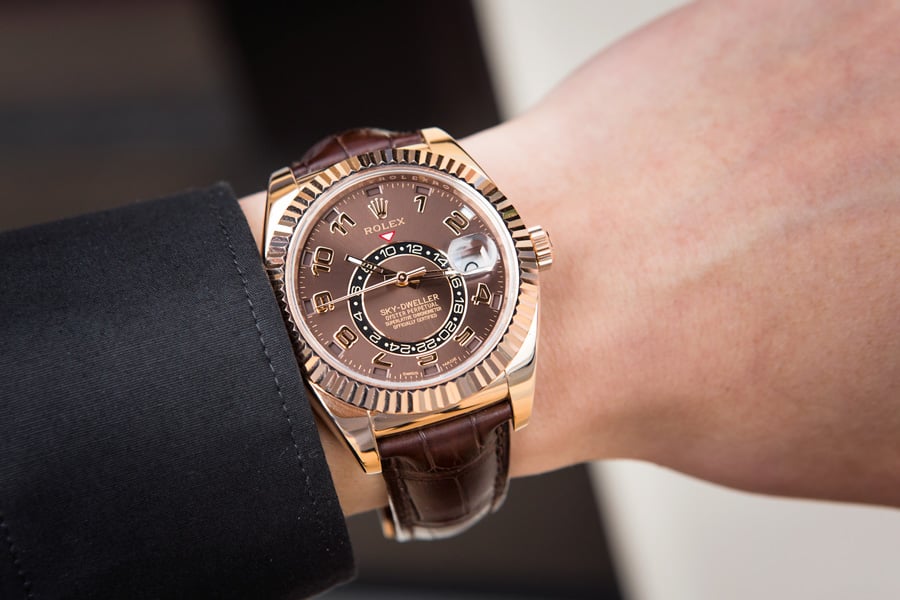Can any watch ever be described as controversial? For those new to horology, it might come across as a somewhat excessive term. However, once you have been immersed in the collecting community for a while and have had a chance to gauge just how deep feelings can run, it starts to sound less extreme.
Perhaps the most controversial moment in the history of the world’s favorite dive watch – the Rolex Submariner – came in the late 1960s when the ref. 1680 emerged; the first reference to sport a date function. For many of the more traditional fans, the ones invested in the brand’s legacy of tough but stylish tool watches, it marked the point at which the Submariner began to stray from its true roots and enter the realm of being a status symbol.
Rolex also seemed to agree. The Rolex 1680, as well as debuting the calendar complication, was also the first model to introduce precious metals to the collection with a solid 18k yellow gold edition. However, contentious or not, it is a fascinating entry into the Submariner chronicles – the one which split the series in two, giving us both date and no-date ranges. There was also a healthy amount of variation within the model during its run, with dial and bezel discrepancies serious aficionados love to pore over and study to the nth degree.
Today, late run examples of the ref. 1680 act as the ideal gateway into vintage Rolex ownership, while the rarest early specimens are incredibly sought-after and often mentioned in similar conversions that include Double Red Sea-Dweller and Bakelite bezel GMT-Master watches. Whatever stage you are at in your Rolex collecting journey, the Submariner ref. 1680 makes a tantalizing target, and so we have put together this comprehensive guide to keep you abreast of all the innumerable details you need to be aware of to make a great purchase.
Read on below to find out all about this iconic dive watch.
Rolex Submariner Reference 1680
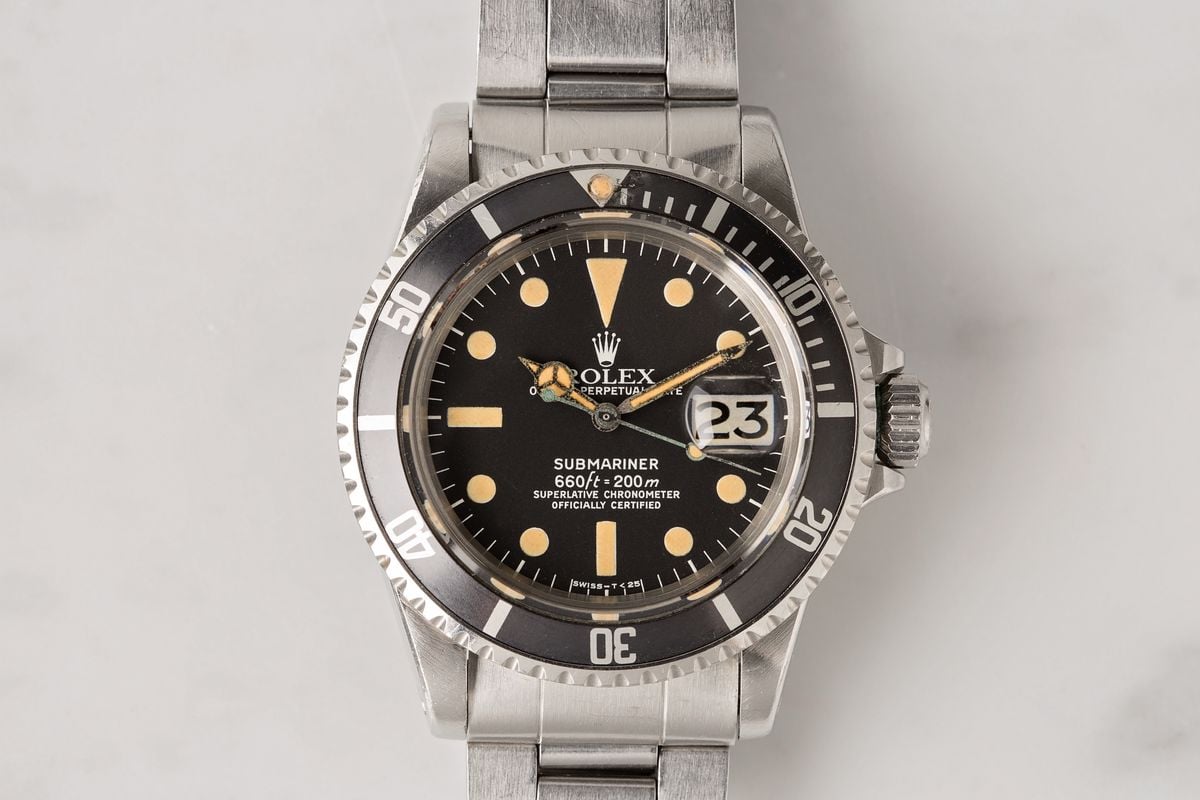
Rolex 1680 Key Features:
– Production Years: 1967 – 1980 (approx)
– Case Size: 40mm
– Materials: Stainless Steel; 18k Yellow Gold
– Functions: Time w/ Running Seconds; Date Display
– Dial: Black; Blue (18k Version Only)
– Bezel: Bidirectional. Black Aluminum Insert w/ 60-minute timing scale
– Crystal: Acrylic w/ Cyclops Magnification Lens
– Movement: Caliber 1575 (Cal. 1570 base)
– Water Resistance: 200 meters / 660 feet
– Bracelet: Oyster Bracelet
Click here for our Ultimate Buying Guide on the Rolex Submariner.
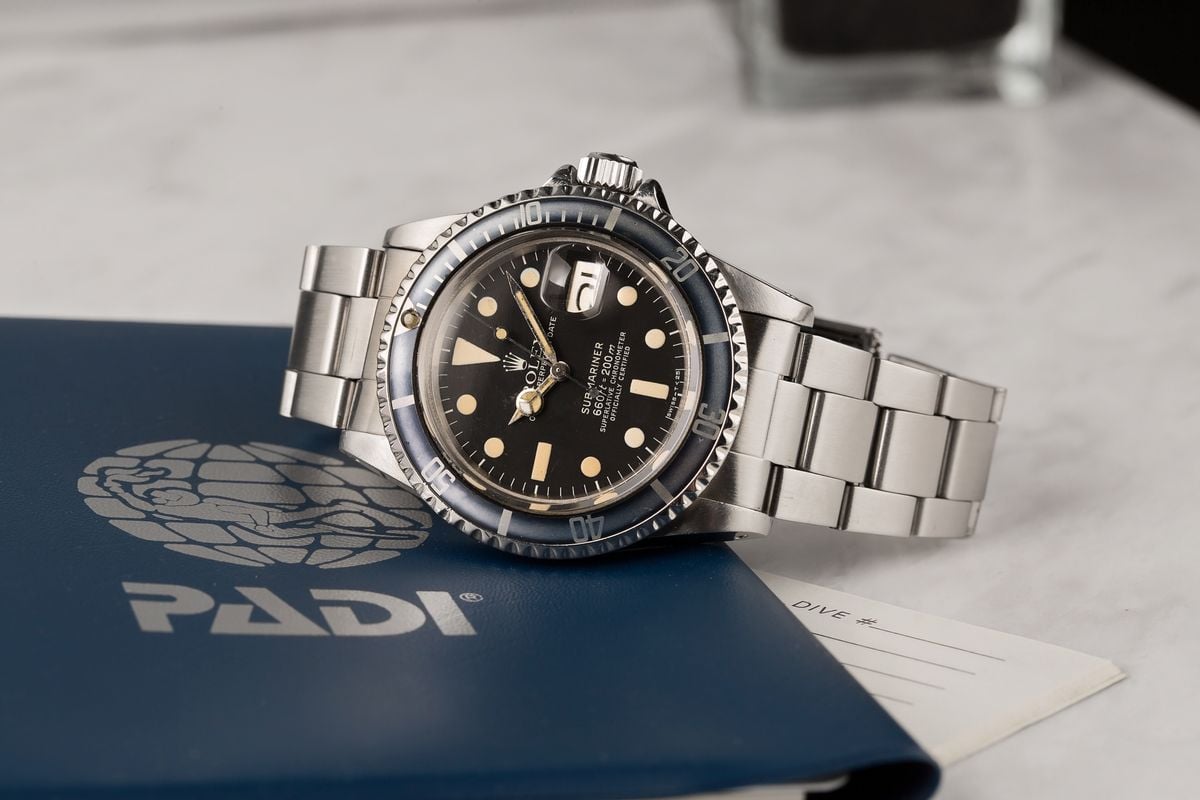
Rolex Submariner reference 1680 History
Despite being such a momentous reference in the life of the most important sports watch of all time, there are some discrepancies regarding the official arrival of the reference 1680. The most probable year for the ref. 1680’s entrance is 1967, but there are several accounts of reference 1680 Submariner watches that have serial numbers that date back as early as 1966.
That puts the ref. 1680 in the same era as two no-date Subs which were running concurrently at the time; the ref. 5512 and ref. 5513. The only real difference between that pair lay in the movement driving them. The ref. 5512 was the (usually) COSC–rated variant, while its partner only ever received non-chronometer calibers. The ref. 5513 was therefore the cheaper option and the one with fewer lines of text on the dial. Rather than replacing those models, the ref. 1680 became the third Submariner reference available.
In terms of essential styling, there was nothing to choose between any of them. After a turbulent first few years in production, with Rolex releasing and quickly retiring numerous versions in an almost constant process of tweaking and revising, the Submariner had settled into its accepted form by 1959. That was the year the ref. 5512 came along, with its 40mm case, crown guards and serrated bezel. This design blueprint was so successful, in fact, that the Sub’s basic shape stayed unaltered right up until 2010.
As for the ref. 1680, it’s production period lasted until 1979 (some say 1980). As well as the established steel model, with black dial and bezel, Rolex also brought out an 18k yellow gold reference at the same time – the ref. 1680/8. Originally, it too had only all-black elements, but in 1971 another variant surfaced, this time with a dial and bezel insert in bright blue.
On both those precious metal models, the brand fitted what are referred to as ‘nipple dials’ by today’s collectors. Instead of the standardized mix of flat dots and baton hour markers printed directly on the surface like on the steel version, the gold models had applied gold indexes that were raised from the surface, with lume in the center.
However, as is usually the case with collectible vintage Rolex sports watches, it isn’t the gold variants that are the most valuable on the preowned market. There is a particular sub-section of the steel series that commands a rabid following from devotees, which we will cover a little later.
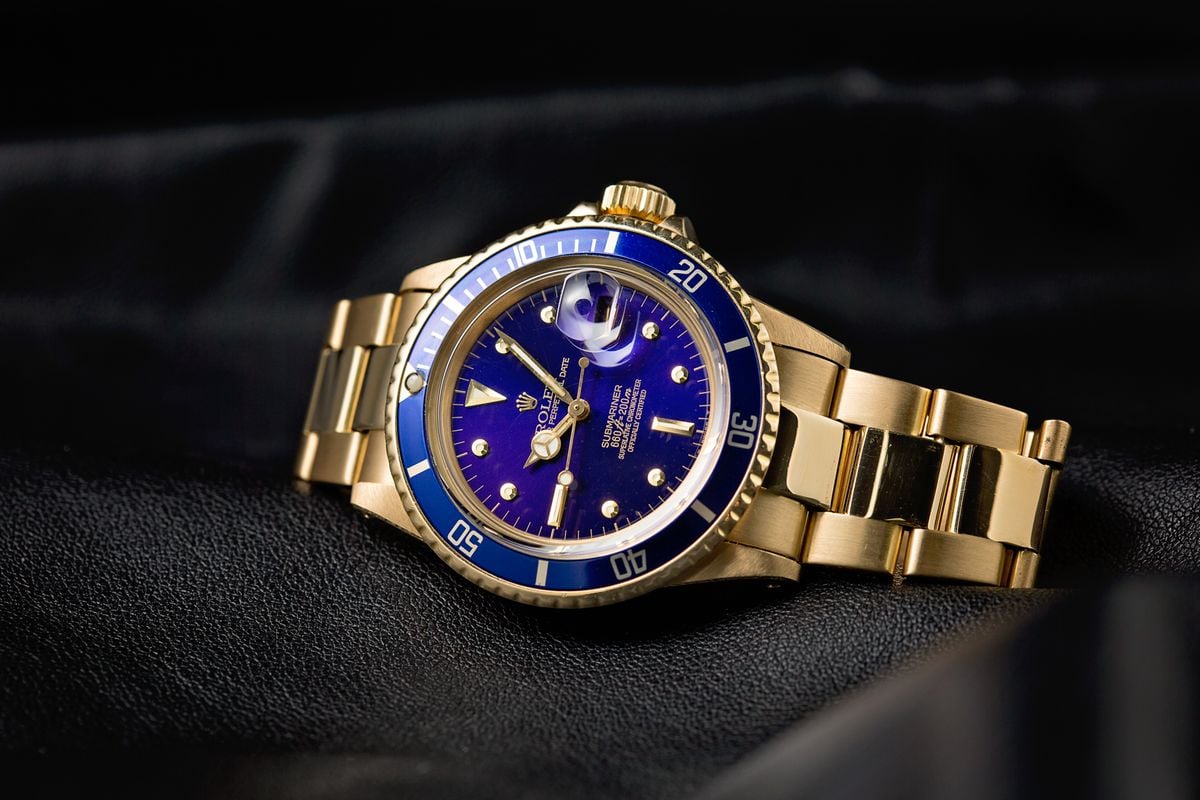
Rolex Submariner 1680 Movements
Unlike the two no-date Submariner models produced at the same time, which upgraded their calibers periodically throughout their runs, the ref. 1680 was only ever fitted with one movement, the Cal. 1575. As with all of Rolex’s 15xx series, the first family of mechanisms the brand created entirely in-house, it is based around the original Cal. 1530.
The Cal. 1575 is actually the third generation in the range, with its balance frequency increased to 19,800vph, and although it is still missing the Quickset date function, it does have the cam and jewel system which causes the instantaneous date change at midnight – something developed for the Datejust several years earlier. Consequently, it is sometimes described as a ‘quick switch, slow set’ movement.
The Caliber 1575 is essentially identical to the Cal. 1570 inside later models of the ref. 5512, except with an additional calendar module included. One strange anomaly shared by all Caliber 1575 movements is the fact that they are stamped ‘1570’ inside on the rotor bridge. Discrepancies like that sometimes act as a red flag to collectors, but in this case, it is completely legitimate. The components are identical on the two movements, and so Rolex simply produced one part and labeled it with the base caliber number – a practice that would never happen today with Rolex’s ultra-standardized production process.
Elsewhere, all is as you would expect with one of the manufacturer’s true workhorse engines. It has a 48-hour reserve, a free-sprung balance and Microstella regulation for precise adjustment, and a Breguet overcoil on the hairspring. In 1972, Rolex added a hacking feature, allowing wearers to stop the seconds hand by pulling out the winding crown, thus making setting the time easier and more accurate. But beyond that, the Cal. 1575 was (and still is) recognized as one of the undisputed greats of mass-produced mechanical watch movements.
Although its level of finishing was never going to win it any Geneva Seals, the Cal. 1575 furthered Rolex’s lifelong maxim of form-following-function and was a movement designed and built to simply carry on working forever, no matter what. The perfect companion for a tool watch, it also powered the first Sea-Dweller references, along with the rest of Rolex’s date-displaying watches of the era. More on Rolex caliber movements here.
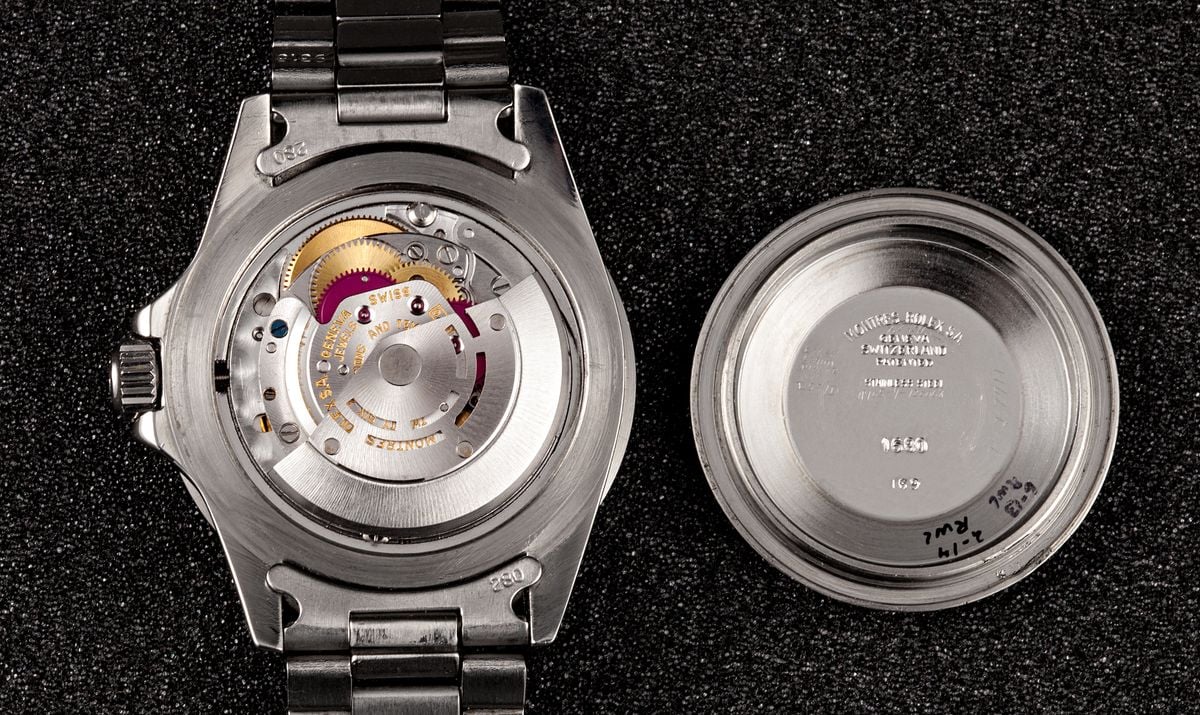
Rolex Submariner 1680 Bezels
The ref. 1680 was the last Submariner to have a bidirectional bezel – that is, one that rotates in both directions. It had long been known that a unidirectional bezel (one which only turns counterclockwise) could act as an important failsafe for divers. Should the watch get knocked during the dive, the bezel could be inadvertently moved, and display an incorrect time. However, if the bezel can only turn counterclockwise, it will over-read the duration of immersion time rather than under-read, thus helping eliminate the risk of decompression sickness (the bends).
Unfortunately for the Rolex brand watches, the patent for unidirectional bezels had been held by Blancpain since 1952, who outfitted one to its Fifty Fathoms model, just a matter of months before the first Submariner was launched. The copyright stayed in place for the entirety of the ref. 1680’s run, and it would not be until the subsequent generation that the Submariner would receive its now-standard unidirectional bezel.
Bezel Variations
As for the bezel itself, its type and condition are among the most value-influencing elements that the watch can have (other than the dial). We are obviously a long way away from the introduction of Rolex’s Cerachrom ceramic material, so all inserts for the reference are made from anodized aluminum. The ones fitted as factory-issue are now referred to as ‘Fat Font’ inserts, due to the thickness of the numerals on the 60-minute scale.
However, because of the nature of the metal, and the corroding effect factors such as seawater or the sun’s UV rays can have, many of these bezels suffered a significant amount of fading over the years. If they were sent into Rolex for service, chances are they would be returned with a replacement insert, with the number font somewhat thinner (called, unsurprisingly, thin font bezels).
For many collectors, it is the fat font examples that command the premium, often regardless of how tarnished or faded they are. To the serious enthusiast, honest condition is everything, even to the point where buying just an original bezel insert on its own can now mean parting with a four-figure sum. We will be covering the bezels a bit more later, in the ‘Authentic Details’ section below.
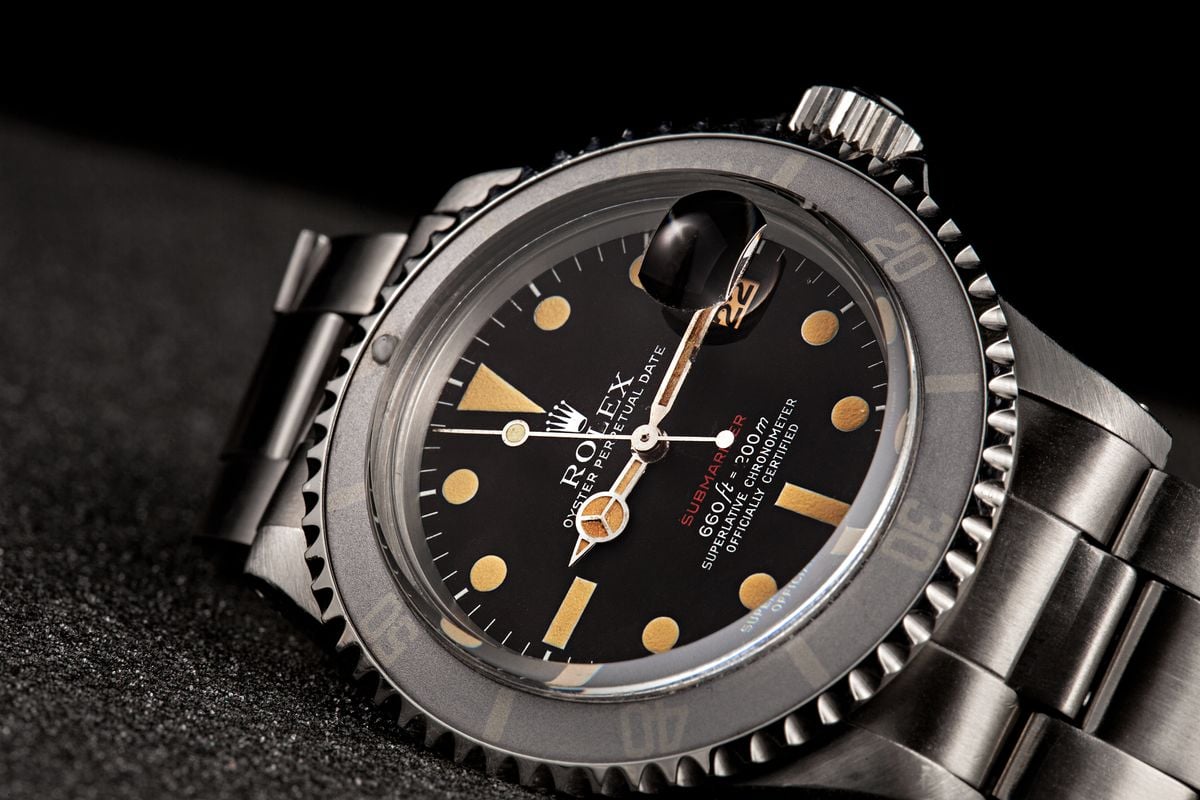
Rolex Submariner 1680 Dials
Okay, here’s where things get a little more involved. As you will probably know, the vast majority of a vintage watch’s value is dependent on its dial, and specifically the rarity and condition. With the ref. 1680, we can really split the reference in two between what are known as red dials and white dials. Only applicable to the stainless steel models, the reason for the distinction is down to a single line of text – the ‘Submariner’ name. Between approximately 1967 and 1975, that script was printed in red, and then from there until the end of the watch’s run, it was written in white to match the rest of the dial’s graphics.
However, the variation doesn’t end there. In the middle part of the 20th century, Rolex didn’t seem able to stop tinkering with its designs once they were in production (likely due to using different dial manufacturers at the time or having dials produced in different batches). Consequently, various details would be slightly different (often minutely), simply due to when the individual watch was produced.
The smallest alteration to a font or word placement (and on the ref. 1680, you actually need a loupe to be able to see some of them) gives us a series of different dial variations (today known as ‘Marks’ by Submariner collectors). A number of these versions are incredibly scarce and are now massively sought after and valuable. The original run of the ref. 1680 (called the Red Submariner) has seven dial variations, while the white variants have three. Below we take you through each one.
Rolex Reference 1680 ‘Red Submariner’ Dial Marks
Even though there are seven dial Marks recognized by the collector community for the Red Rolex Submariner, they are numbered Mark I to Mark VIII. This is because the Mark VIII is a service dial, an extremely rare variation that was never originally fitted to a standard-production Red Submariner, but which would have been used to replace a worn or damaged dial on a watch sent into Rolex for maintenance.
Additionally, it is the Mark VII dials that are usually denoted as the ‘White’ Submariner watches, with it being the first dial with all-white writing. Yet, there are three versions of the white text dial itself that often get overlooked. It is, as I’m sure you are gathering, rather confusing. If it helps, it can be easier to think of there being only six Red Sub Marks, plus a service Mark.
Of those six, three are designated ‘Meters First’ and the other three ‘Feet First’. This is in reference to the depth rating, which by this point in the watch’s development was 200 meters. So, Marks I, II, and III have that written as ‘200M-660ft’ while Marks IV, V, and VI are ‘660ft-200M’. (The current-production range of Submariner watches is also feet first, except now it is ‘1,000ft-330M’).
Let’s take a closer look at the other differences between each dial.
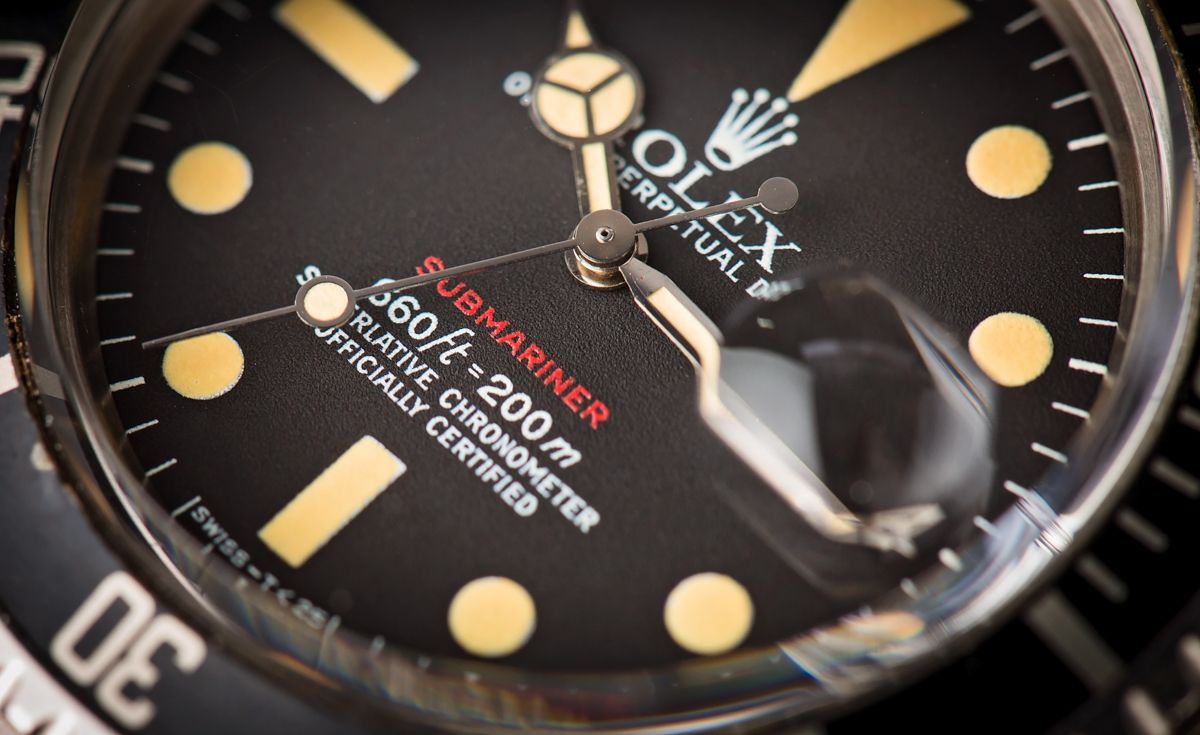
Mark I: The first dial type fitted to the ref. 1680, these feature a distinctly compressed font, with a fairly thick typeface. The Submariner name is in red, printed on top of white lettering. (If you look really closely, you may see the white outline). Additionally, the 6’s in the depth rating are closed, and the F of the ‘ft’ has a long curve.
– Made by Singer
– Issued to models in the 2.07M to 2.2M case range (approx)
Mark II: The Mark II dials, like the Mark I, have the red over-white letter printing, but the font is significantly thinner here. Additionally, the 6’s are open (leaving a tiny gap at the end of the loop, but you will probably need magnification to see it) and the F doesn’t extend as far over the T in ‘ft’.
– Made by Singer
– Issued to models in the 2.2M to 2.45M case range (approx)
Mark III: The Mark III dials were produced at the same time as the Mark II and are so similar they are often mistaken for each other. However, there are differences: the Submariner text is printed in red directly onto the dial, rather than over a white base. Additionally, the F in ‘ft’ is a little shorter too.
– Made by Singer
– Issued to models in the 2.2M to 2.45M case range (approx)
Mark IV: The first of the ‘Feet First’ Marks, we see the return of red printing on top of white for the ‘Submariner’ name, and the dials have a distinctively open 6.
– Made by Singer
– Issued to models in the 2.45M to 3.1M case range (approx)
Mark V: Again, the Mark V dials launched at the same time as the Mark IV, although they stayed in production a little longer. There is no white base layer for the Submariner name here, and while the 6’s are officially open, the gap is far smaller than on the Mark IV and practically impossible to see with the naked eye.
– Made by Beyeler
– Issued to models in the 2.45M to 3.3M case range (approx)
Mark VI: This is the last of the Red Submariner dials to use tritium for its luminescence. The red script is printed directly onto the dial and the 6’s are now fully closed. The ‘S’ in ‘Superlative’ is now much more rounded than on previous Marks.
– Made by Lemrich
– Issued to models in the 3.3M to 4.0M case range (approx)
Mark VII: Commonly known as the White Submariner, we will look at those dials below.
Mark VIII: Rolex stopped producing the Red Submariner dial in the mid-70s, switching to all-white text. If a ref. 1680 was sent in for service after that date and needed a replacement dial, in the vast majority of cases, it would receive one with all-white lettering. However, there are little more than a handful of service dials with red script, often called Mark VIII dials.
These are possibly the easiest to tell apart from the others, since by the time they were issued, Rolex had changed to LumiNova for its lume, replacing the former tritium. As a result, not only is the glow usually brighter, the bottom of the dial will be marked ‘SWISS’ under the six o’clock index, rather than ‘Swiss-T<25’ like on the original Red Sub dials.
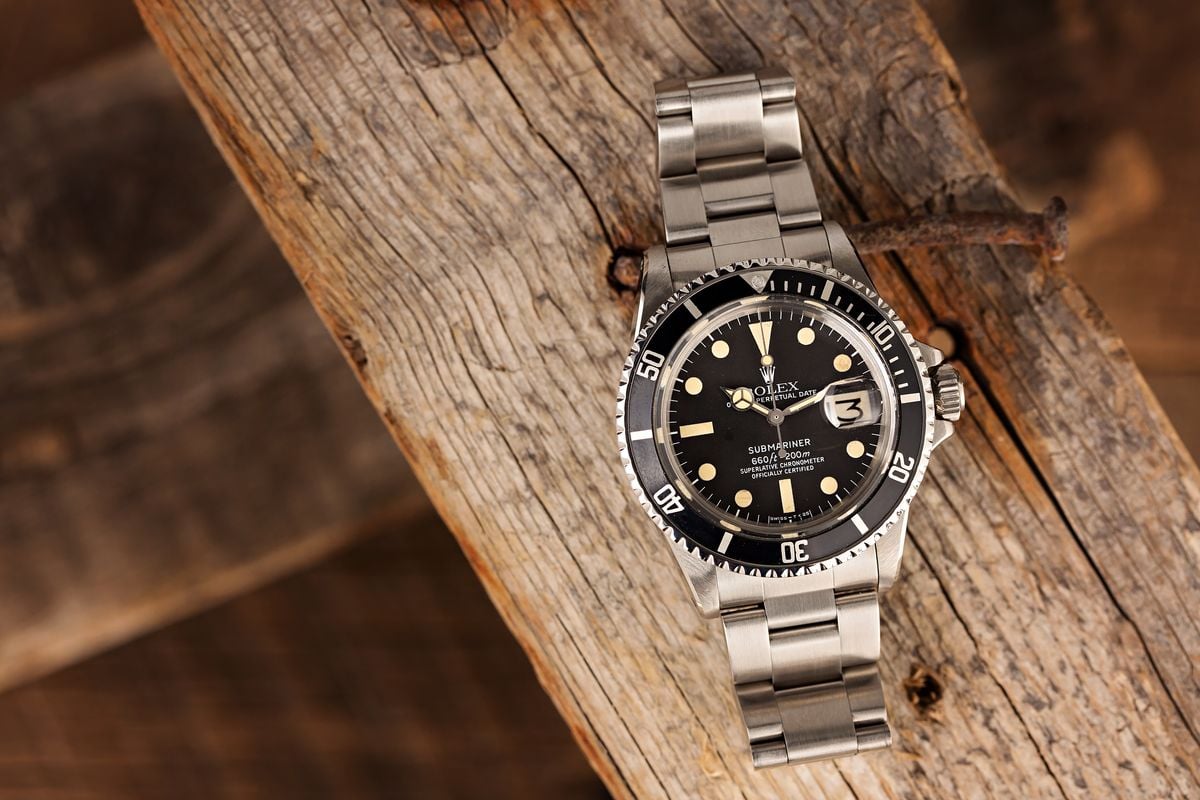
Rolex Reference 1680 ‘White Submariner’ Dial Marks
The three white dials fitted to the ref. 1680 were all feet first versions, all with tritium lume. These were supplied on the models made between approximately 1975 and the end of the watch’s run in 1979/1980. (4.0M and 7M case numbers). And if you thought the Red Sub’s dials were tough to tell apart…
Mark I: On the Mark I dials, the ‘SUBMARINER’ line is the same width as the depth rating line, and the ‘L’ in Rolex is perfectly in the middle under the coronet logo. They also feature closed 6’s.
Mark II: On this iteration, the ‘SUBMARINER’ text is now longer than the depth rating script, the Rolex ‘L’ has shifted minutely to the left, and the 6’s are open.
Mark III: Sort of a mix between the Mark I and II, the Mark III has closed 6’s and the off-centered ‘L’.
*Note: there are also three white service dials made as spares and not fitted to production models, but the differences are so negligible that we will not be covering them here.
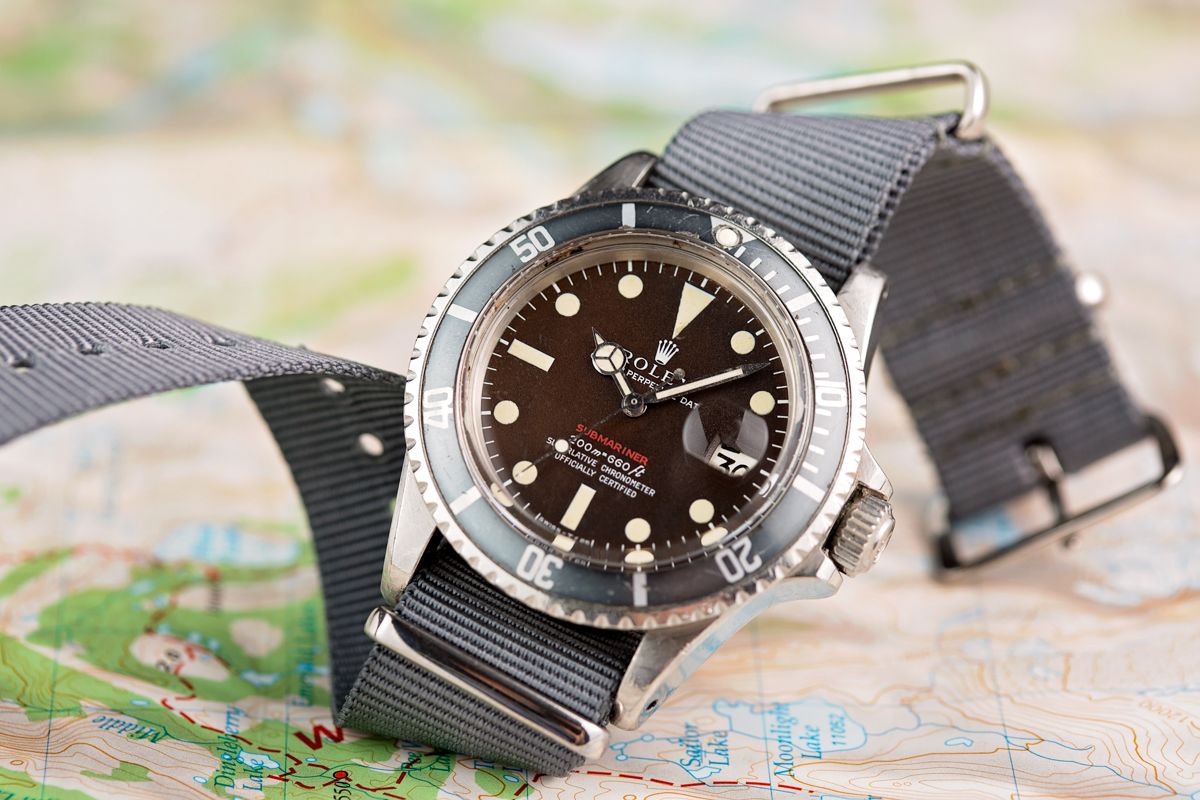
Rolex Submariner 1680 Bracelets
The ref. 1680 was fitted with the three-link Oyster bracelet. Like the dials, these also evolved during its run, and there were (officially) three different types overall.
Bracelet References
Ref. 7206: Fitted to the first run models, the ref. 7206 is a steel bracelet with riveted links and 80 end pieces.
Ref. 9315: Generally considered the ‘correct’ bracelet for the Red Submariner, the ref. 9315 was introduced early on and lasted until the mid-70s, featuring folded links and either the 280 or 380 end links.
A few points to note:
– ‘9315’ should be stamped on one of the links just before the end piece.
– The end-links should also be stamped, with either 280 or 380.
– The ref. 9315 unveiled the diver expansion clasp and the earliest examples have ‘Pat Pend’ stamped on it when unfolded. These are known as the Patent Pending bracelets and are usually the most expensive on the vintage market.
– Once the copyright was awarded, Rolex started stamping the clasp with a ‘Patented’ label. Except, on the first run of those (between 1970 and 1972), an unnoticed spelling mistake left the bracelet with the legend ‘Pateted’ instead, with no one seemingly spotting the missing ‘N’. These examples are now, of course, more in demand than those with the proper spelling. You may also come across ‘Pateted’ clasps on some ref. 5512 and 5513 Subs, the ref. 1665 Sea-Dweller, and even some ref. 1016 Explorer watches, where the diver extension could be added as a special order.
– The clasps were also date stamped up until 1972, so those without dates are from 1973 onwards.
Ref. 93150: The ref. 93150 emerged in 1976 (and so is the bracelet fitted to all White Submariner 1680 watches) and had solid side links. While they are the least desirable in terms of collectability, they are the most robust and modern-feeling of the three. They all come with 580 end links, and their clasps are stamped with initials that identify their year -‘VA’ for 1976, ‘VB’ for 1977, ‘VC’ for 1978 and ‘VD’ for 1979.
There are two other bracelet types that are sometimes found on the ref. 1680. The first doesn’t have a reference number but is known simply as a ‘USA Made Riveted’ bracelet. These have no diver extension or additional safety latch and the end pieces aren’t stamped. The only identification is a date mark on the clasp, and these are sometimes regarded as having a less refined feel than the Swiss-made equivalents.
The final variety is the ref. 7836 folded link Oyster, originally made for the Explorer II and the GMT-Master of the same era. As such, they are also missing the diver’s extension and safety latch, but they can take the 280 or 380 end pieces and so fit perfectly on the ref. 1680.
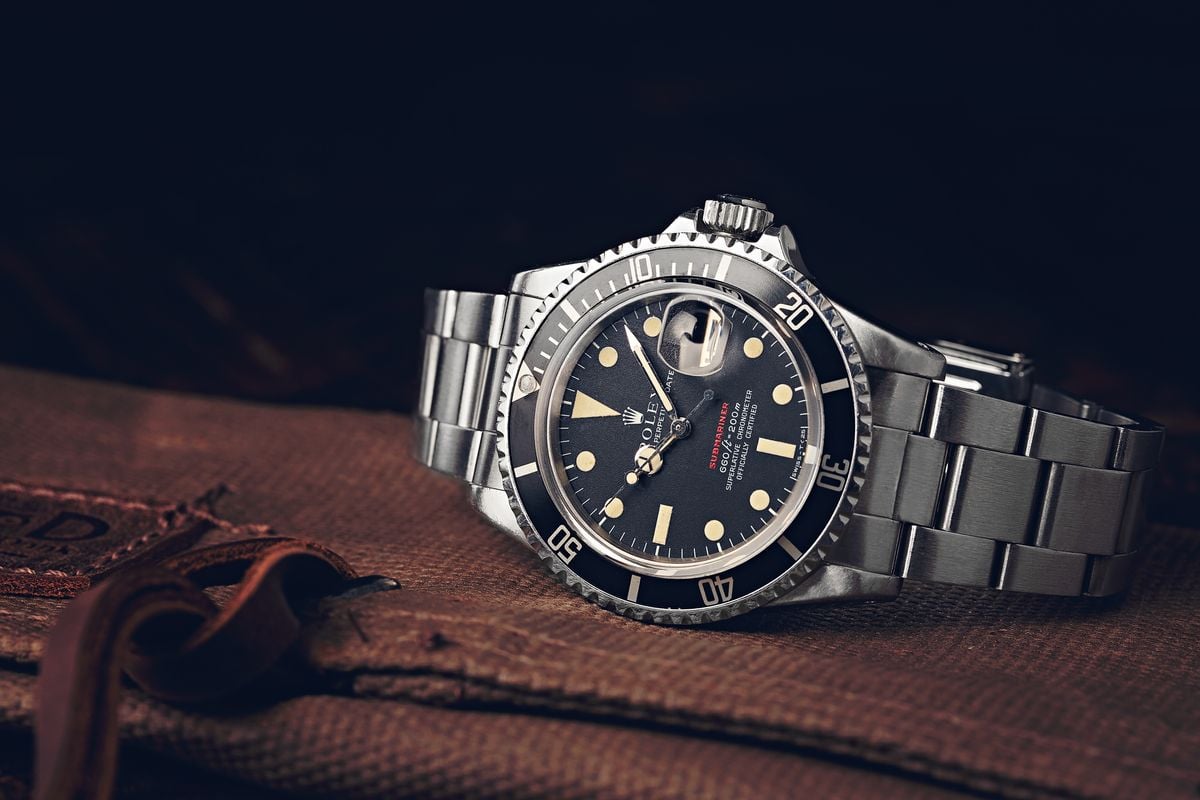
Rolex Submariner 1680 Authentic Details
Even though it was the first of its kind, in many ways the reference 1680 could be described as a transitional reference – it introduced new features, but still retained plenty of elements from previous models. Of course, with the watch’s production run now being so long ago, finding a completely authentic example, with every component still original rather than a service replacement, is getting more and more difficult, and increasingly expensive.
On top of that, there is the constant menace of fakes circulating the industry, or those cobbled together from spare parts, known as Frankenwatches. Therefore, as well as the dial, bezel and bracelet minutiae we mentioned above, there are a few other pointers to keep in mind and knowing a little about what you should expect to see on a genuine ref. 1680 is an important guide in determining a fair price on the vintage market.
Rolex 1680 Crystal
As well as being the only Submariner Date with a bidirectional bezel, the ref. 1680 is also the only date-displaying model with an acrylic crystal and the first to have the Cyclops magnifying lens. That crystal is also quite special and unique to the reference. Known in collector circles as a ‘Top Hat’ crystal, it is an especially tall item, protruding around 3mm above the case and bezel.
The originals had right angles and were box-shaped before a second iteration was given small bevels a few years later. These first and second-generation Top Hat Crystals have a wonderful vintage flair to them that many fans love.
Rolex 1680 Crown
The initial models of the ref. 1680 were fitted with Twinlock crowns. The system, invented in 1953 for the very first Submariner, contains a set of O-ring gaskets that help form two sealed zones within the crown assembly to ensure its water resistance. Unlike today, where Rolex marks its crowns with either dots or bars below the coronet insignia, the original version fitted to the ref. 1680 has no markings under the logo at all.
The brand then went on to invent the Triplock crown in 1970, with an updated design that offers three watertight zones. These were used for the ref. 1680 from approximately 1973 onwards. The Triplock crowns were given three dots under Rolex’s coronet emblem. However, any of the earlier models sent in for a service after that date may well have had their Twinlock crown swapped for a Triplock one, as the updated design offers superior water resistance.
Although there is rarely much of a premium applied for a watch with its original Twinlock crown, it can often be something that can act as a yardstick by which to gauge the authenticity of the rest of the watch. Additionally, while factors such as the dial, case, and bezel all play a much greater role in determining value, the presence of an original crown only helps to increase the overall price and collectability of a reference 1680 watch.
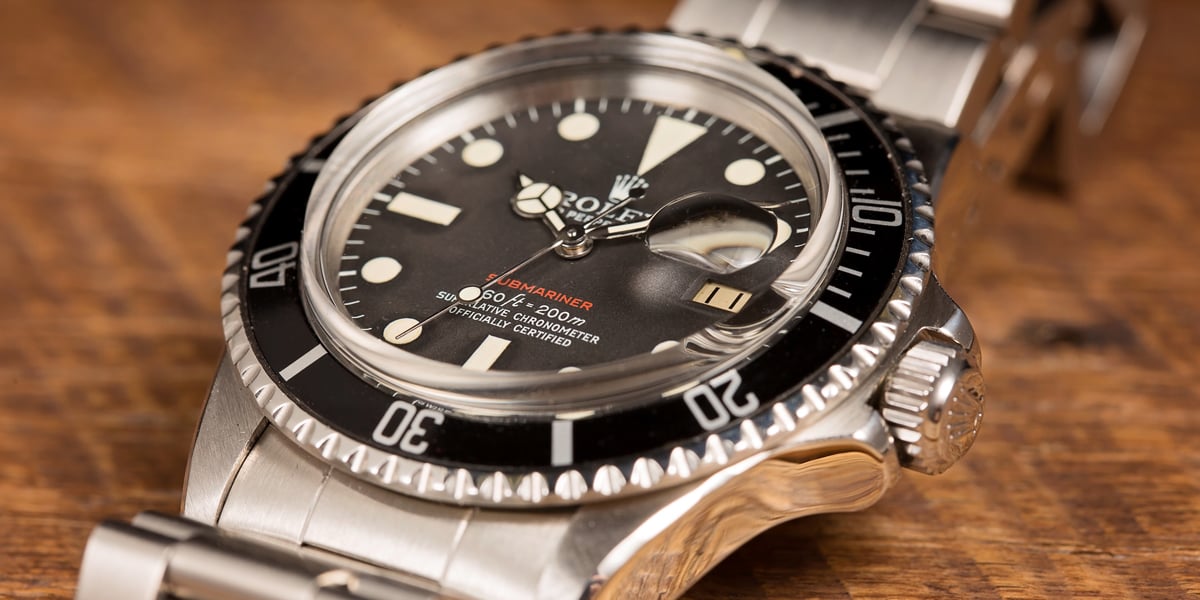
Rolex 1680 Date Wheel
The factory-issued date wheel on all ref. 1680s had a brushed silver metallic finish, and all the 6s and 9s were open (apart from on the 26, which was closed for some reason). You may come across two other types which would have been fitted at service.
The first is very similar to the original except the silver finish is non-metallic. Some speculate that these may have originally been made for the Ref. 1675 GMT-Master and later used as replacement parts. The other kind is white in color (just like the ones Rolex produces today), but here every 6 and 9, including the 26, is open.
Rolex 1680 Case-Back
As with the bracelets, earlier versions of the ref. 1680 had a date code stamped on the inside of their case-backs. These started at ‘II 69’ for those made in 1969, and went up to ‘II 72’ for those produced in 1972.
After 1973, Rolex did away with dating the watch and so you won’t see the code on any model after that. Additionally, service replacement case-backs were not given dates either, so that is something to keep in mind should you see a pre-1972 model that does not have a date marking on it.
Rolex 1680 Bezel Inserts
Like the dials, there are also different Marks of bezel insert for the ref. 1680. However, telling one from the other is such an enigmatic and inexact science that a lot of it comes across as little more than guesswork. Below is the list of the four main types you are likely to encounter.
Mark 1: The Mark I inserts can be identified by what is known as the ‘Kissing 40’ where the 4 numeral touches the 0 with no gap in-between. These were the first inserts used on the ref. 1680, between 1967 and 1970.
Mark 2: The Mark IIs are sometimes called the ‘Long 5’ inserts, where the 5 in the 50 numeral has a slightly longer drop. In addition, the internal space of the 4 digit is a perfect triangle, where it is more trapezoidal on other Marks.
Mark 3: Very similar to the Mark I, but with a break between the 4 and 0, and there is a slight serif to the characters. Some diehard purists insist this is the only correct bezel for a White Submariner ref. 1680.
Mark 1 to Mark 3 are ‘Fat Font’ inserts.
Mark 4: Really a Mark 3.5, these have a thinner font than the Mark 3, but are otherwise identical.
As stated, this is all very approximate and can be open to interpretation. For example, a Mark 3 insert can look like a Mark 1 because its 4 and 0 numbers are touching, but that may also be down to Rolex’s printing machinery wearing out and causing the numerals to bleed into each other. In truth, this is one of those areas where enlisting the help of an expert before you part with any money is to be advised – especially considering the prices that the scarcer inserts trade hands for at the moment.
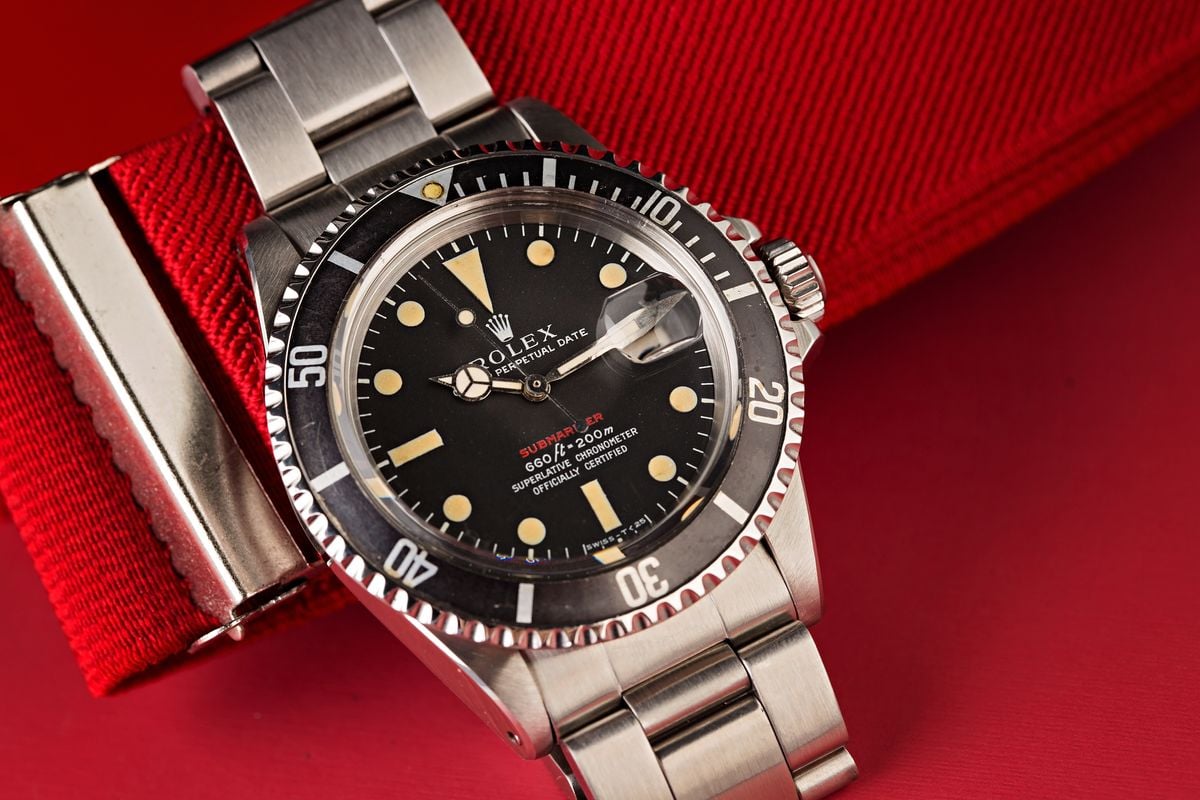
Rolex Submariner reference 1680 Ultra Rare Variations
The Rolex Submariner ref. 1680 is already a relatively rare watch and as such, it can be an expensive prospect adding one to the collection. Prices start at around $10,000 for a white dial example, while the Red Sub opens at around twice that. With that in mind, there are (as is always the case when concerning vintage Rolex watches) especially scarce oddities that can add massive amounts onto the ref. 1680’s already significant value.
Chocolate Submariner 1680
All of the stainless steel ref. 1680 watches came with matte black dials. Yet, what was most likely down to a defect in the paint has caused a tiny handful of those faces to change color and turn a rich chocolate brown color. Otherwise known as Tropical, these dials are only found on fairly early models, usually the Mark II or III, and only on a very small number of those. As such, they are fantastically scarce, massively sought after, and highly valuable.
It is uncommon but not unheard of, even for a company as esteemed as Rolex, to suffer these quality control glitches. The ‘Patrizzi’ dial Daytona watches, which see the outer ring of their sub-dials turn brown over time (again because of a flaw in manufacturing) are another example. As you would expect, Rolex replaced most of these dials at service, making them even more difficult to track down now, and they qualify as a grail watch for many vintage Submariner fans.
Fuerza Aérea del Perú Submariner 1680
Rolex has been supplying watches to various international military forces for many years, and their relationship with the Peruvian Air Force (or Fuerza Aérea del Perú) goes back to 1962. As well as Daytona (and pre-Daytona), GMT-Master, and Turn-O-Graph watches (all of which make a certain amount of sense as aviation timepieces), the FAP also took delivery of a number of ref. 1680 Submariner watches. Probably even more scarce than the Chocolate 1680 Subs, they were all supplied with standard dials but had certain case back engravings which identify them as being very special indeed.
As well as their entire serial number, the backs are inscribed with ‘Fuerza Aérea del Perú’ in a Roman sans-serif font and filled in black enamel (the enamel will have generally all worn away by now). Additionally, you may find a specific military-issue code, although these engravings were fairly shallow and will possibly have disappeared over time with wear. To describe these watches as ‘rare’ is an understatement. In total, across all models, Rolex supplied only around 700-800 watches to the FAP, so when they do surface for sale, it is always something of an event.
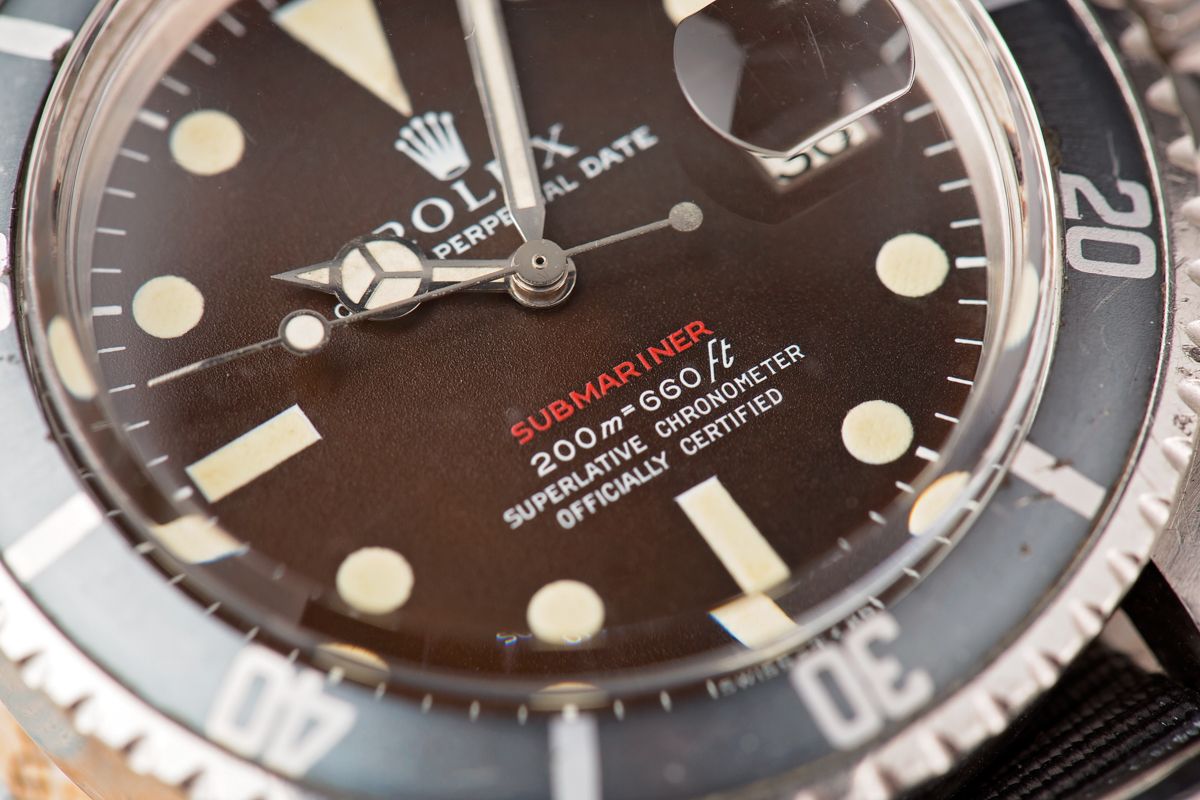
Final Thoughts on the Rolex 1680 Submariner
So there we have our guide to the Rolex Submariner 1680. You will have inevitably worked out by now that it is a reference that went through a huge amount of variety during its relatively brief run, and that is reflected in the enormous gaps between the cheapest and most expensive examples available on the pre-owned market.
The lowest price models just creep into five figures, while the exceptionally rare pieces with handsomely discolored dials can easily reach into six-figure territory. While it may have marked the shift in the Submariner’s role from purpose-built dive watch to desk diver, there’s no doubting its importance in the model’s overall story. As solid an entry point into vintage Rolex as you’ll find, the ref. 1680 is a truly iconic reference.
